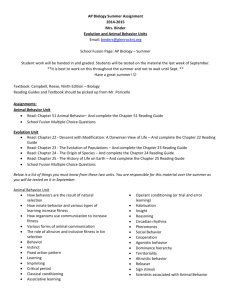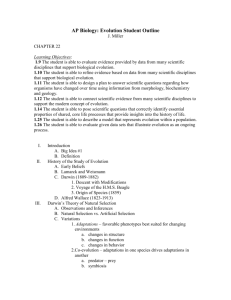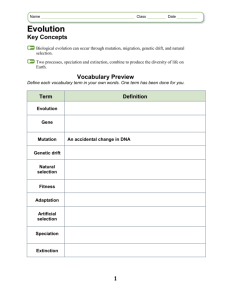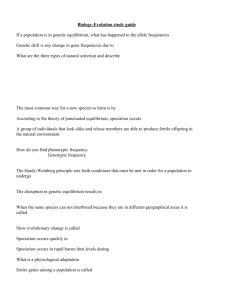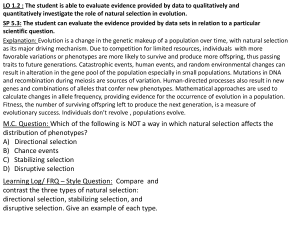Big Idea 1A: I can statements I can define the terms: environment
advertisement
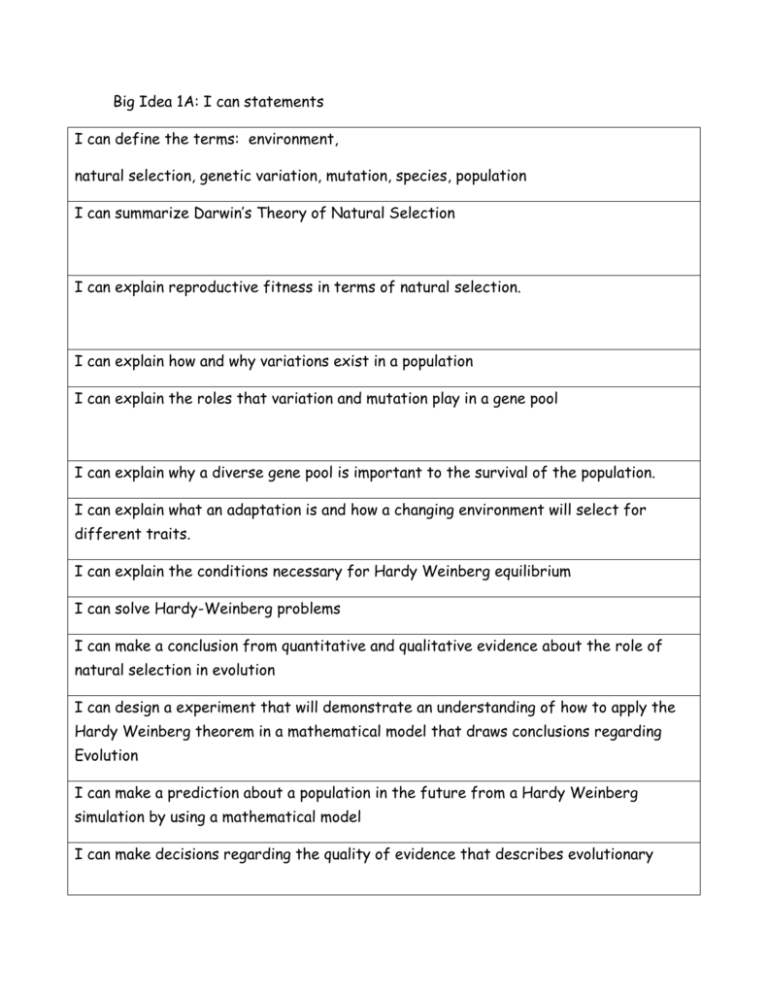
Big Idea 1A: I can statements I can define the terms: environment, natural selection, genetic variation, mutation, species, population I can summarize Darwin’s Theory of Natural Selection I can explain reproductive fitness in terms of natural selection. I can explain how and why variations exist in a population I can explain the roles that variation and mutation play in a gene pool I can explain why a diverse gene pool is important to the survival of the population. I can explain what an adaptation is and how a changing environment will select for different traits. I can explain the conditions necessary for Hardy Weinberg equilibrium I can solve Hardy-Weinberg problems I can make a conclusion from quantitative and qualitative evidence about the role of natural selection in evolution I can design a experiment that will demonstrate an understanding of how to apply the Hardy Weinberg theorem in a mathematical model that draws conclusions regarding Evolution I can make a prediction about a population in the future from a Hardy Weinberg simulation by using a mathematical model I can make decisions regarding the quality of evidence that describes evolutionary changes in the genetic makeup of a population over time I can explain genetic drift I can explain my data from a mathematical model regarding a Hardy-Weinberg based genetic drift simulation I can predict the effects of genetic drift, migration and artificial selection on the genetic makeup of a population I can cite evidence from many scientific disciplines that support biological evolution I can explain what a vestigial structure is I can identify morphological, biochemical, or genetic homologies between different types of organisms I can make a decision about the quality of evidence from many scientific disciplines that support biological evolution I can analyze a phylogenic tree based on allele, morphological or biochemical data I am able to compare and contrast evidence from many scientific disciplines to support the modern concept of evolution I can design a plan to answer scientific questions regarding how organisms have changed over time using information from morphology, biochemistry and geology. Big Idea 1B: I can statements: I can describe the characteristics of Archaea, Bacteria and Eukarya I can compare and contrast the characteristics of the three domains to underscore the evolutionary relatedness I can justify the claim that organisms share many conserved core processes and features that evolved and are widely distributed among organisms today. I can define what a species is. I can identify shared characteristics in a phylogenetic tree or cladogram I can make an inference about the evolutionary history of the group in the phylogenetic tree or cladogram I can identify character data that could improve or extend a phylogenetic tree or cladogram. I can make a decision regarding the quality of a phylogenetic tree or cladogram when given a data set I can create a phylogenic tree that represents evolutionary history and speciation from a data set I can explain adaptive radiation I can compare and contrast punctuated equilibrium and gradualism Big Idea 1C: I can statements: I can give an example of an extinction and discuss how speciation was affected I can analyze data regarding speciation and extinction that has occurred throughout the Earth’s history I can design a plan to collect data to investigate that speciation and extinction has occurred throughout the Earth’s history I know what speciation is and can identify the types of speciation (allopatric and sympatric) I can compare and contrast allopatric and sympatric speciation I can explain reproductive isolation I can compare and contrast the types of pre and post zygotic barriers I can analyze data based on graphs or models of types of selection to predict what will happen to the population in the future I can justify the selection of data that supports reproductive isolation and speciation. I can identify if a speciation is due to a change in gene frequency, change in environment, natural selection, and/or genetic drift I can describe a model that represents evolution in a population I can look at a data set and determine if evolution is an ongoing process in that situation. Big Idea 1D: I can statements: I can describe a scientific hypothesis about the origin of life on Earth I can compare and contrast the organic soup model and solid reactive surface model to create polymers from monomers that have the ability to replicate, store and transfer information. I can evaluate the scientific questions based on hypothesis about the origin of life on Earth. I can explain why there have been revisions on the hypothesis regarding the origin of life on Earth. I can explain the RNA World hypothesis. I can make decisions about the accuracy and legitimacy of data to answer scientific questions about the origin of life on Earth I can cite geologic, molecular and genetic evidence that supports our current models of the origin of the Earth


